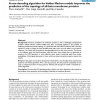Free Online Productivity Tools
i2Speak
i2Symbol
i2OCR
iTex2Img
iWeb2Print
iWeb2Shot
i2Type
iPdf2Split
iPdf2Merge
i2Bopomofo
i2Arabic
i2Style
i2Image
i2PDF
iLatex2Rtf
Sci2ools
BMCBI
2005
2005
A new decoding algorithm for hidden Markov models improves the prediction of the topology of all-beta membrane proteins
Background: Structure prediction of membrane proteins is still a challenging computational problem. Hidden Markov models (HMM) have been successfully applied to the problem of predicting membrane protein topology. In a predictive task, the HMM is endowed with a decoding algorithm in order to assign the most probable state path, and in turn the labels, to an unknown sequence. The Viterbi and the posterior decoding algorithms are the most common. The former is very efficient when one path dominates, while the latter, even though does not guarantee to preserve the HMM grammar, is more effective when several concurring paths have similar probabilities. A third good alternative is 1-best, which was shown to perform equal or better than Viterbi. Results: In this paper we introduce the posterior-Viterbi (PV) a new decoding which combines the posterior and Viterbi algorithms. PV is a two step process: first the posterior probability of each state is computed and then the best posterior allowe...
Related Content
| Added | 15 Dec 2010 |
| Updated | 15 Dec 2010 |
| Type | Journal |
| Year | 2005 |
| Where | BMCBI |
| Authors | Piero Fariselli, Pier Luigi Martelli, Rita Casadio |
Comments (0)

